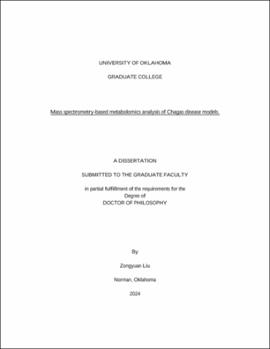| dc.contributor.advisor | McCall, Laura-Isobel | |
| dc.contributor.advisor | Yang, Zhibo | |
| dc.contributor.author | Liu, Zongyuan | |
| dc.date.accessioned | 2024-04-04T14:02:21Z | |
| dc.date.available | 2024-04-04T14:02:21Z | |
| dc.date.issued | 2024-05-10 | |
| dc.identifier.uri | https://hdl.handle.net/11244/340221 | |
| dc.description.abstract | Chagas disease (CD) is a neglected tropical disease which is caused by the parasite Trypanosoma cruzi. Approximately 6 to 7 million people in the world are infected with T. cruzi. The symptoms at the acute phase are mild or non-specific, so most people won't get treatment, which leads to the chronic phase. 20% to 30% of people in the chronic phase will develop Chronic Chagas Cardiomyopathy which is the primary reason for death in CD cases. Current drug treatments are limited and have to be given in the acute phase for best efficacy. Therefore, the major challenge of CD is prevention for people in endemic regions and treatment during the chronic phase. This dissertation applied untargeted and targeted metabolomics based on mass spectrometry to investigate the metabolic perturbation induced by progression to symptomatic disease after infection, treatment effects of vaccine-linked chemotherapy and protection effects of prophylactic vaccines. We combined LC-MS/MS with various data science methods for higher resolution and deeper insights in complex biological samples. Our findings extend knowledge about disease progression and failure of traditional treatments. In addition, we evaluated novel vaccine candidates for better protection and treatment efficacy. Clearance of the parasite does not restore metabolites, but successful restoration of metabolites by a therapeutic vaccine combined with benznidazole led to better health status in chronic mouse models. Immune responses from single candidate vaccines showed better protection than combined immunization. Multiple metabolites, including lipids, amino acids and nucleotides showed strong correlation with multiple immune response transcriptome and miRNA expression indicators. The NGP24h vaccine showed the largest difference for these metabolites compared to other vaccine groups. However, there were few metabolites correlated with the parasite load. This distinction between parasite burden and metabolic changes was found across the projects reported here. Overall, these results reveal molecular mechanisms of CD treatment and immune response protection, based on simultaneous effects on the pathogen and on host small molecule responses. This link between infection and subsequent persistent small molecule perturbation broadens our understanding of infectious disease and has potential applications for other disease models. | en_US |
| dc.language | en_US | en_US |
| dc.rights | Attribution-NoDerivatives 4.0 International | * |
| dc.rights.uri | https://creativecommons.org/licenses/by-nd/4.0/ | * |
| dc.subject | Chagas disease | en_US |
| dc.subject | Metabolomics | en_US |
| dc.subject | Vaccine | en_US |
| dc.subject | Biomarker | en_US |
| dc.title | Mass spectrometry-based metabolomics analysis of Chagas disease models | en_US |
| dc.contributor.committeeMember | Masly, John | |
| dc.contributor.committeeMember | Cichewicz, Robert | |
| dc.contributor.committeeMember | Fornelli, Luca | |
| dc.date.manuscript | 2024-02-16 | |
| dc.thesis.degree | Ph.D. | en_US |
| ou.group | Dodge Family College of Arts and Sciences::Department of Chemistry and Biochemistry | en_US |
| shareok.orcid | 0000-0003-4050-4900 | en_US |

